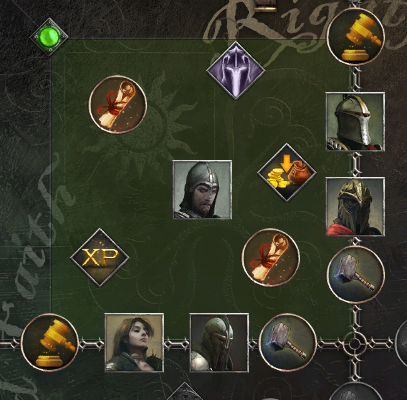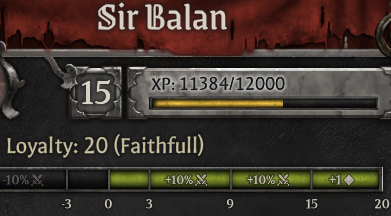I have played a couple of hundred hours between EA and Beta. Here is, if not a FAQ, then things I wish I’d known if I were to start today.
What difficulty should I play on?
The game was originally designed with only one difficulty equivalent to Hard, and from my experience the game is balanced around that.
- Sir Leodegrance Sage
- Sir Bedivere Vanguard
- Black Knight Champion
- White Knight Champion
Tier 2. Available approx mid act 2. Join as level 9
- Sir Lucan Sage
- Sir Geraint Marksman
- Sir Dagonet Arcanist
- Sir Damas Marksman
Tier 3. Available approx mid act 3. Join as level 15
- Sir Lancelot Champion
- Sir Galahad Defender
- Red Knight Defender
- Morgana LeFay Arcanist
Typically, you’d unlock 5 heroes through Morality Chart in a playthrough

Are the Morality unlocked heroes worth it ?
- The Tier 3 ones in particular have pretty unique skills (as in access to skills from a different class).
- By definition, the Morality unlocked heroes have similar alignment to you/Mordred, thus increasing their loyalty.
- The quests to get them are always worth doing, for loot, XP and fun, even if you end up keeping them in the Aspirant slots.
What are the Aspirant slots?
Unfortunately you can move heroes freely from the Aspirant Slots to the active hero roster if you have free slots in the latter, BUT not the other way around: To free slots in the active roster you need to dismiss a hero permanently (or let a hero die, leave…).
And yes it sucks not being able to move heroes from active list to an aspirant slot, I hope that changes…
Is there advantages of staying neutral in the Morality Chart?
Is maxing loyalty of a companion worth it? And how can I do it?

To increase loyalty:
- Give them Titles (see Round table), you’ll unlock more titles as you progress in the main quest.
- Random events can also increase or decrease loyalty.
- Be aligned with them on the morality chart.
- Look at the traits of each hero, some have unique ways to gain/lose loyalty.
- There are trinkets items that give a few (+2) loyalty points.
Can the hero appearance be customised?
(There is an alternative skin for Mordred, unlocked by subscribing to a newsletter, but that is the one exception, and may be unavailable by the time you’re reading this)
How big is the party?
For example the missions where you recruit new Heroes, you get your 4 original heroes + the 5th being the one you’re recruiting.
I am struggling with the tactical combat any tips?
- When selecting a melee opponent a red outline appears (areas where the enemy can move to and attack) and an orange one (where the enemy can move to but can’t attack). Sometimes the best option is to step back from the threatened area and pass: Let the enemy use his AP to move and you have bonus APs for the next round, when they’re close.
- With your melee heroes, close down on enemy ranged attackers: Enemy archers will have to shoot with a penalty or move and trigger an attack of opportunity.
- Inversely: kite the big melee enemies: They are usually slow and can be slowed down further with hexes, knockbacks and the like.
- Backstab enemies, but avoid getting backstabbed yourself: You can change orientation of your heroes at no AP cost. Ranged attacks can also “backstab”.
- I also found Taunt a particularly useful skill if one of your heroes have it: Not only will the enemies try to attack your Defender rather then the squishy next to them, but they can trigger overwatches and attacks of opportunity as they try to close in on the Taunter.
What should I build/upgrade in Camelot as a priority?
If your alpha team is injured or otherwise unavailable and the backup heroes are 3 levels below the only available quest, you could be in a situation where even reloading an old save can’t save your run.
On a side note this building is also the one you need to refund skillpoints: It costs some gold and the hero will be unavailable for 1 week.
Which one of the classes is the healing class?
During combat you’ll find the only way to reliably restore health is a healing potion.
That said there are preventive ways to avoid losing health to begin with: Skills to increase armour temporarily, grant a temporary pool of bonus HP or even evading or absorbing damage altogether.
Between fights, campfires and the odd healing shrine is what you have to rely on. Use them strategically, don’t necessary use them as you stumble upon them.
I have 4 AP why can’t I use my skill that costs 4 AP?
Note that you can save Green APs for next round at a rate of 6/3/1 saved APs to get 3/2/1 AP next round. Yellow APs are not carried over.
Also note that movement skills (Dash, Charge,…) do use Green APs by default, even though they fundamentally are “movement”.
What were the classes again?
* Defender. A sword and board tank.
* Champion. Melee DPS warrior
2 Medium Armour Classes:
* Vanguard. Rogue-like class, if your idea of rogue also lays traps
* Sage. Support/Buff/Melee class
2 Light Armour Classes:
* Marksman: Ranged bow damage. Fire/Poison dots
* Arcanist: Spellcaster / debuffer.
How different are Heroes of the same class.
Sometimes it changes the class flavour quite a bit. Like Mordred has lightning based skills, Galahad Fire skills, Red Knight some DPS skills including a throwing axe, Palleas is more of a classical tank, with taunts and armour skills…. Despite them all being Defenders.
Any final advice?
Also explore the map even when the main mission of a given map is done: Side quests, side duels, side encounters, the odd vitality healing shrine or treasure chest (sometimes requiring high Spellcraft or Perception) may remain unclaimed if you just hit the “Finish Mission” when it becomes available.
More Guides:
- King Arthur Knight’s Tale: All Hidden Chests in the Main Campaign
- King Arthur Knight’s Tale: How to Add Color & Vibrance
